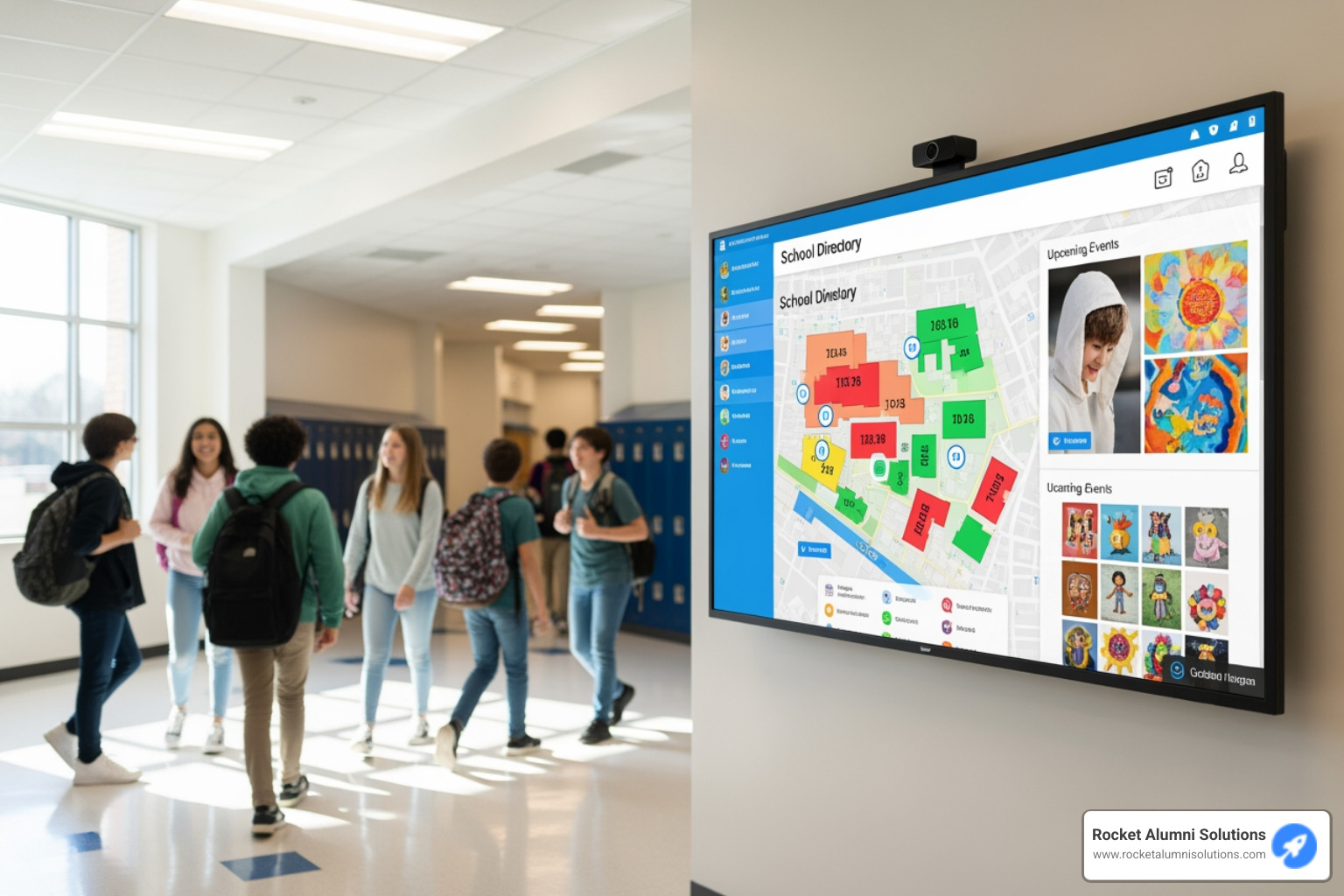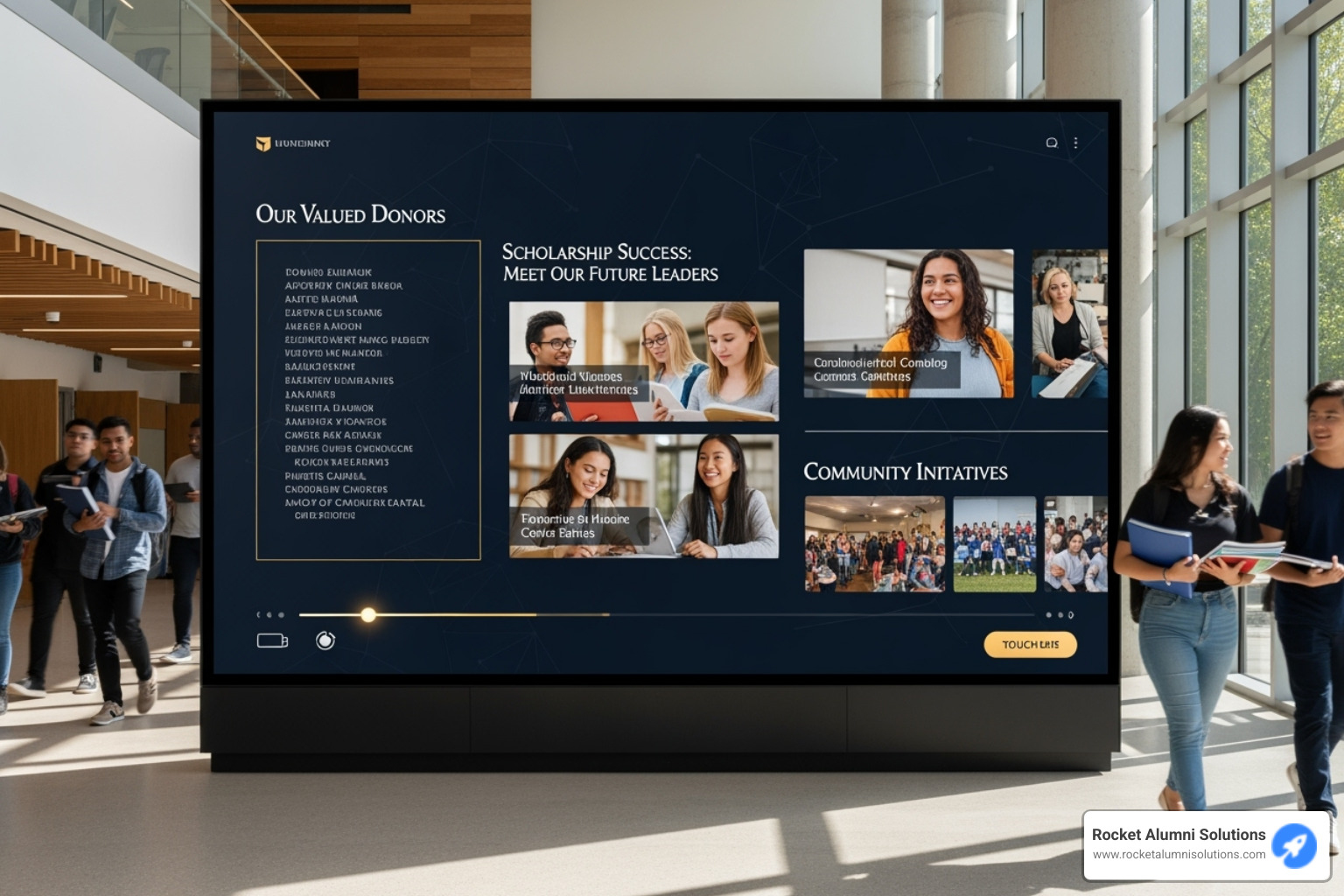Why Your School's Championship Legacy Deserves More Than a Banner
A State Championship Display Touchscreen is an interactive digital system that replaces or supplements traditional banners and trophy cases, allowing schools to showcase unlimited championships through multimedia content including videos, photos, player profiles, and season statistics. These commercial-grade displays solve the space constraints of physical recognition while providing searchable, updateable, and engaging ways to celebrate athletic excellence.
Key Components of a Championship Touchscreen System:
- Display Hardware: Commercial-grade touchscreen (43"-75") designed for continuous use
- Content Platform: Cloud-based software for managing championships, teams, and athlete profiles
- Interactive Features: Search by sport, year, athlete name, or achievement level
- Multimedia Integration: Video highlights, photo galleries, season statistics, and team narratives
- Instant Updates: Add new championships within days without vendor involvement or physical modifications
Walk into any successful high school gymnasium and you'll see championship banners hanging from the rafters—visible proof of years of dedication and hard-fought victories. But what happens when you run out of ceiling space? What about the championships from decades ago that have been taken down, or the trophies hidden in storage because the display case is full?
Traditional recognition methods face unavoidable limitations. A standard trophy case holds 20-40 trophies comfortably, yet a typical athletic program accumulates 18-36 new awards annually. After just five years, you're facing impossible choices about what to display and what to hide. Banners fade, deteriorate, and consume valuable space. Most frustratingly, these static displays tell incomplete stories—just a year, a sport, and maybe a score, with no room for the players, coaches, and moments that made those victories meaningful.
Digital touchscreen displays eliminate these constraints entirely. A single screen can showcase every championship in your program's history across all sports, with unlimited capacity for photos, videos, player profiles, and season narratives. Students can search for their relatives' achievements from decades earlier. Alumni visiting campus can explore their own championship seasons. Prospective athletes and their families can dive deep into your program's tradition of excellence—all without requiring a single additional square foot of wall space.
I'm Chase McKee, Founder & CEO of Rocket Alumni Solutions, where we've helped over 1,000 schools nationwide create interactive State Championship Display Touchscreen systems that preserve their athletic legacies and build lasting community pride. Through this work, I've seen how the right digital recognition platform transforms not just how schools celebrate the past, but how they inspire future champions.
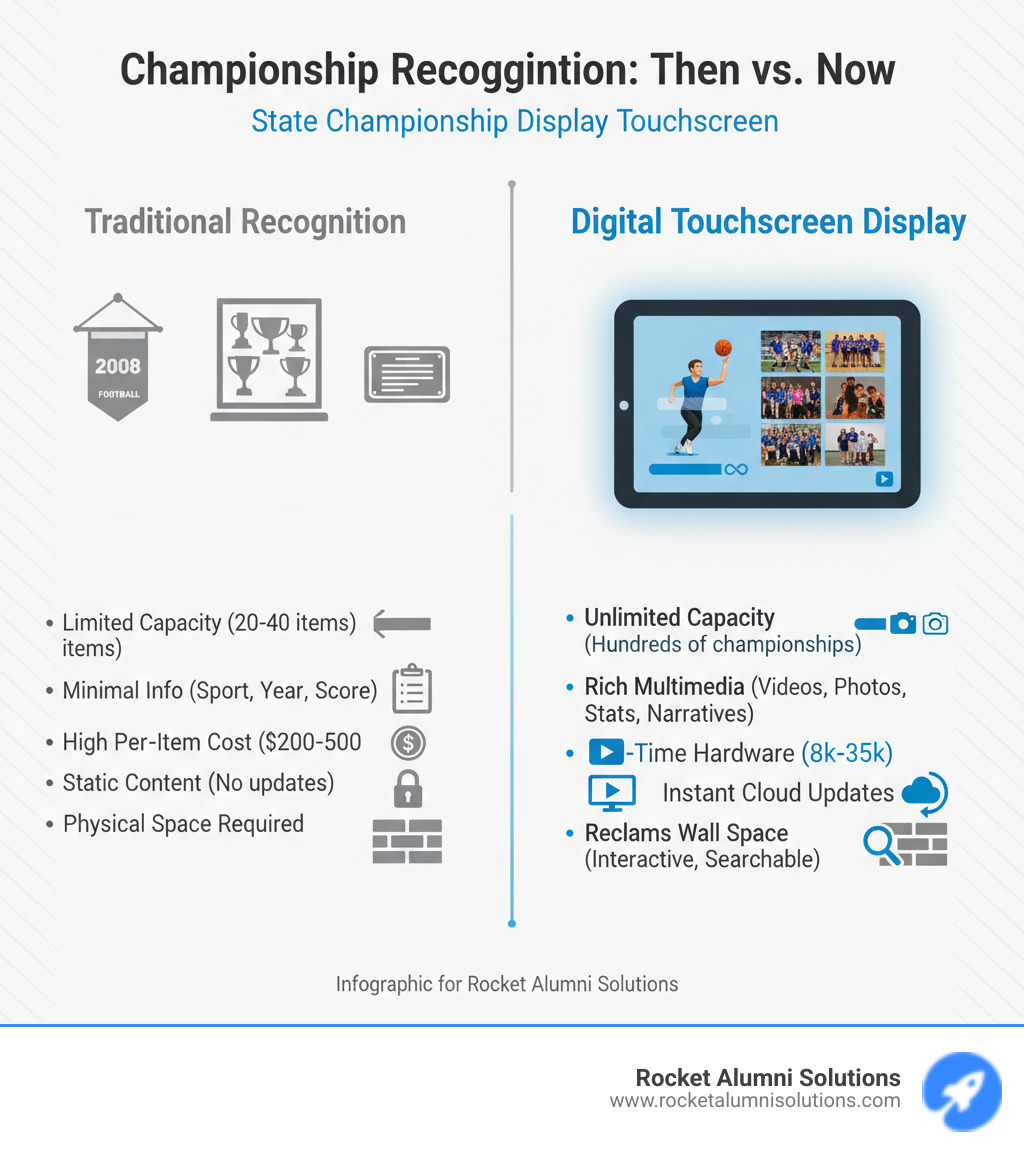
State Championship Display Touchscreen vocab explained:
Why Digital Displays are a Game-Changer for Championship Recognition
The shift from static displays to interactive touchscreens represents a fundamental upgrade in how we honor athletic achievements. These systems solve long-standing challenges that have plagued schools for decades, while simultaneously creating exciting new opportunities for celebration and engagement.
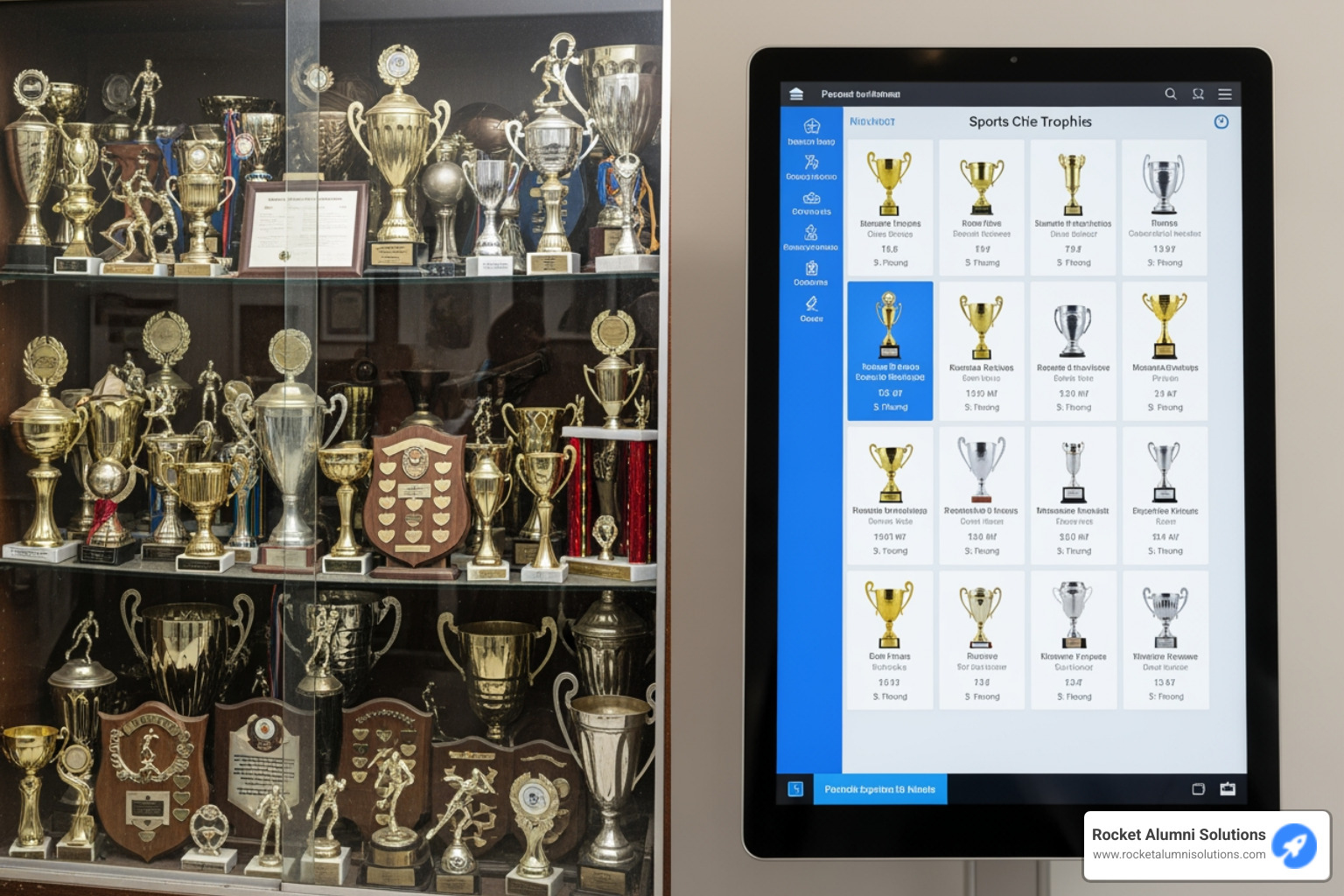
Overcoming the Limitations of Traditional Methods
Walk past any trophy case in an established high school and you'll likely see the same problem: crowded shelves with trophies pushed to the back, some turned sideways to fit, others relegated to storage rooms where nobody will ever see them again. It's a problem that gets worse every year.
The numbers tell a sobering story. A typical glass-fronted trophy case comfortably holds about 20-40 trophies. Meanwhile, a successful athletic program accumulates 18-36 new awards annually. Do the math, and you're facing impossible choices after just five years—which achievements deserve to be displayed prominently, and which must be hidden away?
Our research shows that the average high school with established athletic programs has 60-70% of its trophies and awards in storage simply because there's nowhere to put them. That's not just a space problem—it's a recognition problem. When you hide achievements, you're essentially telling athletes their accomplishments don't matter as much as someone else's.
Banners create their own headaches. They look great when they're first hung, but what happens five or ten years later? Colors fade under gymnasium lights. Materials wear and tear. Installation costs add up quickly—typically $200-500 per banner—and that's before you factor in the ongoing maintenance or eventual replacement.
But the biggest limitation is what traditional methods can't tell you. A banner shows the sport, the year, maybe the achievement level. That's it. Who were the players? What made that season special? What was the score of the championship game? All of that context—the human stories that make victories meaningful—gets lost completely.
A State Championship Display Touchscreen eliminates every one of these constraints. Space becomes unlimited. A single screen can showcase every championship in your program's history across all sports, from your founding season through last week's victory. No more difficult decisions about what to display and what to hide. No more faded banners or crowded shelves.
The transition from physical trophy cases to digital displays isn't just about freeing up space—it's about fundamentally better recognition. Every achievement gets honored equally. Every athlete gets their moment. And unlike digital trophy displays that simply replace one static image with another, interactive touchscreens create engaging experiences that bring your history to life.
Enhancing Storytelling and Engagement
Here's where digital displays truly shine: they transform recognition from something you glance at in passing to an experience you actively explore. Instead of just seeing a name and a year on a banner, visitors can dive into the complete story of what made that championship season special.
The multimedia possibilities are remarkable. Video highlights let you relive game-winning plays and championship celebrations. Player profiles showcase individual athletes with photos, statistics, and personal narratives about their journey. Season statistics provide the detailed numbers that sports enthusiasts love to explore. Photo galleries capture the emotion and camaraderie of championship seasons—the bus rides, the practices, the tears of joy after the final whistle.
Interactive timelines create a chronological journey through decades of success, letting viewers see how your program has evolved over time. Imagine a prospective athlete exploring your football program's history, clicking on the 1985 state championship, watching the game-winning touchdown, reading about the coach who built the dynasty, then jumping forward to see how the program continued that tradition of excellence.
This is what interactive digital banner recognition makes possible—complete championship stories that engage visitors in ways static banners never could. Our data shows visitors typically spend 3-7 minutes exploring interactive displays, compared to just seconds glancing at traditional banners. That's not just more engagement—it's deeper connection with your athletic heritage.
The search and filter capabilities create personalized experiences for everyone. A student can search for their grandfather's name and find he was part of the 1978 basketball championship team. Alumni visiting for homecoming can explore their own championship seasons, reliving memories they haven't thought about in years. Prospective athletes and their families can filter by sport and see the complete tradition they'd be joining.
Modern touchscreen interfaces make all this complexity feel simple and intuitive. Whether you're a tech-savvy teenager or a grandparent who barely uses a smartphone, the experience is welcoming and easy to steer. Touch a sport, pick a year, explore the story—it's that straightforward.
And with online halls of fame, this engagement extends far beyond your school's walls. Alumni across the country can explore your athletic heritage from their living rooms. Parents can share their child's achievements with relatives who couldn't attend the ceremony. Your program's excellence becomes accessible to anyone, anywhere, anytime.
That's the real game-changer: a State Championship Display Touchscreen doesn't just solve the space problem or preserve history—it makes that history come alive in ways that inspire the next generation of champions.
Key Features to Look for in a State Championship Display Touchscreen
Choosing the right State Championship Display Touchscreen system involves evaluating both the physical hardware that will serve your school for years to come and the software platform that brings your championship stories to life. Think of it as building a house—you need both a solid foundation and a beautiful, functional interior. This section covers the essential features your school needs to ensure a successful, engaging, and long-lasting installation.

Essential Hardware Components
The physical display is the centerpiece of your recognition system, and it needs to withstand daily use by hundreds of students, staff, alumni, and visitors. Its durability, size, and responsiveness are critical for a successful long-term installation, especially in high-traffic areas like school lobbies or gymnasiums.
When we help schools select hardware, we start with commercial-grade screens engineered specifically for continuous public use. These displays operate 16-24 hours a day, seven days a week, with operational lifespans of 50,000-70,000 hours. That's dramatically different from consumer televisions, which are designed for a few hours of daily use in living rooms. The last thing you want is a failing screen just a few years after installation. When you choose appropriate touchscreen displays built for institutional environments, you're investing in reliability and longevity.
Screen size matters more than you might think. We typically recommend displays between 43" and 75" for comfortable interaction and visibility from various distances. Larger screens, like the 65-inch models we often install, can support up to 40 simultaneous touches, making them perfect for collaborative exploration when a team gathers around to relive a championship season together.
The touchscreen technology itself should feature multi-touch capability using Projected Capacitive (PCAP) technology—the same responsive, intuitive interface you use on your smartphone every day. This allows multiple users to interact with the display simultaneously, whether they're searching for different championships or zooming into photos together. The clarity, brightness, and responsiveness of PCAP technology creates an optimal user experience that feels natural and engaging.
You'll also need to consider mounting options based on your available space. Wall-mounted solutions save valuable floor space and create a sleek, integrated look in hallways or lobbies. Freestanding kiosks offer flexibility for placement and can be moved if your needs change. Many schools also invest in custom wraps that encase the display in school colors and branding, making the system feel like a natural part of your campus rather than just another piece of technology.
Finally, an integrated compute module is essential for smooth operation and easy content updates. Our bundles typically include a dedicated, commercial-grade computer module running Android OS, often an Elo Backpack, which is a tamper-proof computer that ensures reliable performance and simplifies remote management. For example, our 65" Interactive Touch Screen Hall of Fame Bundle includes a powerful Elo Backpack 5 Android Computer Module that handles all the processing while remaining completely hidden from view.
Critical Software Functionalities for a State Championship Display Touchscreen
While the hardware provides the canvas, the software is truly the brain of the operation. It enables easy updates, intuitive navigation, and rich content presentation, changing a static screen into a dynamic historical archive that tells complete championship stories. For schools with extensive athletic histories, robust software makes the difference between a functional display and a truly transformative recognition experience.
The most important feature is a cloud-based content management system. This is absolutely non-negotiable. A cloud-based platform allows school staff to manage content from anywhere with internet access, requiring minimal time and zero technical expertise. You shouldn't need to be a programmer or graphic designer to update your championship display. This means you can add new championship teams within days of victories, ensuring timely celebration while the excitement is still fresh. Our professional digital recognition software is designed specifically for this purpose, making updates as simple as filling out a form.
Customizable templates are equally crucial. The software should offer purpose-built templates for trophies, achievements, team rosters, and individual athlete profiles. These templates ensure consistent branding and allow you to create professional-looking content without needing graphic design skills. You're celebrating championships, not learning Photoshop.
For user experience, advanced search and filtering capabilities are what separate a basic digital display from a truly interactive experience. Users should be able to effortlessly search by athlete name, graduation year, sport, achievement level, or keywords. This personalized exploration is a major advantage over traditional displays where finding a specific championship from twenty years ago requires scanning dozens of banners. When you explore touchscreen software selection, prioritize platforms that make navigation intuitive for everyone from elementary visitors to elderly alumni.
The platform must seamlessly support rich multimedia integration—videos, high-resolution photos, audio clips, and detailed statistics. This is where championship stories truly come alive. A banner can tell you that the basketball team won state in 2015. A State Championship Display Touchscreen can show you the game-winning shot, introduce you to each player, display the season statistics, and let you hear the coach's championship speech. That's the difference between recognition and celebration.
Beyond the physical touchscreen, web and mobile accessibility extends your recognition reach dramatically. The same content displayed on your lobby screen should be accessible online, allowing alumni to connect with their championship memories from anywhere in the world. This creates year-round engagement opportunities and makes your investment work harder for your school community.
Finally, ensure the software receives regular updates and ongoing support. Technology evolves rapidly, and your platform should evolve with it through feature improvements and technical support. Your investment should remain current and functional for years to come, not become outdated the moment you install it.
The Implementation Process: From Content Curation to Installation
A successful launch of your State Championship Display Touchscreen requires more than just great hardware and software—it needs a clear plan. The most impressive technology in the world won't create meaningful connections if the content isn't compelling or the display isn't where people can actually see it. From gathering decades of championship history to designing an intuitive interface and choosing the perfect location, every step matters.
Think of implementation as building a bridge between your school's past achievements and future inspiration. It's not just a technical project; it's a community effort that often brings together staff, students, and alumni in the shared mission of preserving and celebrating your athletic legacy.

Developing and Curating Your Championship Content
The heart of your State Championship Display Touchscreen is its content. Without rich, accurate, and engaging stories, even the most sophisticated touchscreen is just an expensive piece of glass. A systematic approach to research and organization is essential for creating a comprehensive historical archive that truly honors your program's achievements.
Start with historical research. For schools with decades of athletic tradition—whether you're in Northwest Missouri or following in the footsteps of institutions like Harvard Innovation Labs—comprehensive documentation can feel overwhelming. We recommend digitizing yearbooks as a foundational step. These publications are goldmines of information, containing team photos, rosters, season recaps, and individual achievements that might not exist anywhere else. Old newspapers, school archives, and athletic department records are also invaluable sources. Don't overlook the power of interviewing alumni and retired coaches, who often remember details and stories that never made it into official records.
Next comes photo and video collection. High-quality visual content transforms your display from an information database into an emotional experience. Gather team photos, action shots, celebration moments, and any available video footage from championship seasons. This might involve scanning physical photos from yearbooks or personal collections, contacting local media outlets for archived footage, or putting out calls to your community for contributions. The quality doesn't have to be perfect—a grainy photo from a 1970s championship season often carries more emotional weight than a pristine modern image.
Writing team narratives is where you bring the facts to life. Beyond just names, dates, and scores, craft compelling stories that capture what made each championship special. What challenges did the team overcome? Who were the standout players and coaches? What was the defining moment of the season? These narratives don't need to be lengthy—even 2-3 paragraphs can provide meaningful context that static banners never could.
Verifying records is absolutely paramount. Accuracy builds trust and honors the athletes properly. Cross-reference information with state athletic association records like those maintained by NFHS, school archives, and other historical sources. This is especially important when recognizing individual achievements like all-state honors, which represent less than 1% of student-athletes and deserve careful verification. Even in sports like cross country, where team scores are paramount, individual recognition for top performers requires accurate documentation.
Finally, implement systematic digital asset management practices from the start. Use consistent naming conventions for your files (like "2015FootballStateChampionship_TeamPhoto.jpg"), create logical folder structures organized by sport and year, add comprehensive metadata tags that make searching easy, and establish quality control processes. This organization might seem tedious initially, but it ensures that five years from now, when you're adding new championships or updating old ones, you won't be hunting through hundreds of unlabeled files trying to find what you need.
Design and Placement for Maximum Impact
The physical location of your State Championship Display Touchscreen and its visual design are just as important as the content it contains. You could have the most comprehensive championship archive ever assembled, but if it's tucked away in a corner where nobody sees it, or if the interface is confusing to steer, you won't achieve the engagement and inspiration you're hoping for.
Strategic placement starts with understanding traffic patterns in your building. Where do students naturally congregate? Which areas do visitors pass through? Where would athletes and their families be most likely to explore your program's history? The best locations typically include gymnasium lobbies and entrances, where the display serves as a powerful first impression for recruits and visiting teams. Main school entrances or common areas ensure that the recognition reaches beyond just the athletic community to celebrate excellence with the entire student body. Athletic training facilities or weight rooms provide daily inspiration for current athletes. Even cafeterias or student gathering spaces can work well, creating unexpected moments of findy.
Schools like Buford High School and Wayne Valley High School have found success by creating multiple touchpoints rather than relying on a single display. This ensures championship recognition reaches diverse audiences and maximizes your investment. A display in the main lobby celebrates achievements with the entire school community, while one in the athletic facility specifically inspires current athletes.
Visual hierarchy and school branding should guide your design choices. The interface should feel distinctly connected to your school's identity through color schemes, logos, and typography. Use clear visual hierarchy to guide users through the content—larger, bold headings for sports and years, prominent placement for championship trophies and titles, and intuitive icons that indicate what's clickable. Resources about sports hall of fame design can provide additional guidance on creating visually compelling championship recognition that balances aesthetics with functionality.
User-friendly navigation is non-negotiable. The interface should be so intuitive that a visiting grandparent or a curious middle schooler can explore without any instruction. Interactive halls of fame provide interfaces that make complex information archives easily navigable for all ages and technical skill levels, with simple search functions, clear category organization, and obvious "back" buttons. Every user should feel confident diving into your school's history.
Don't forget to consider the physical viewing experience. Mount the display at an appropriate height—typically with the center of the screen at about 4.5 to 5 feet from the floor—so it's comfortable for both tall adults and shorter students to interact with. Pay attention to lighting conditions. Windows or overhead lights that create glare on the screen will frustrate users and reduce engagement. If your ideal location has challenging lighting, consider architectural adjustments like window treatments or repositioning. Digital trophy cases can be strategically placed in multiple high-traffic areas, each optimized for its specific lighting and space conditions, maximizing both exposure and community engagement.
Maximizing ROI: Integrating Your Display with School-Wide Strategy
A State Championship Display Touchscreen is far more than just a tribute to the past—it's a powerful strategic asset that builds your program's future, strengthens community connections, and delivers measurable returns on investment. For institutions like Northwest Missouri State or the University of Maryland, this represents a long-term investment in institutional pride that pays dividends across multiple areas.
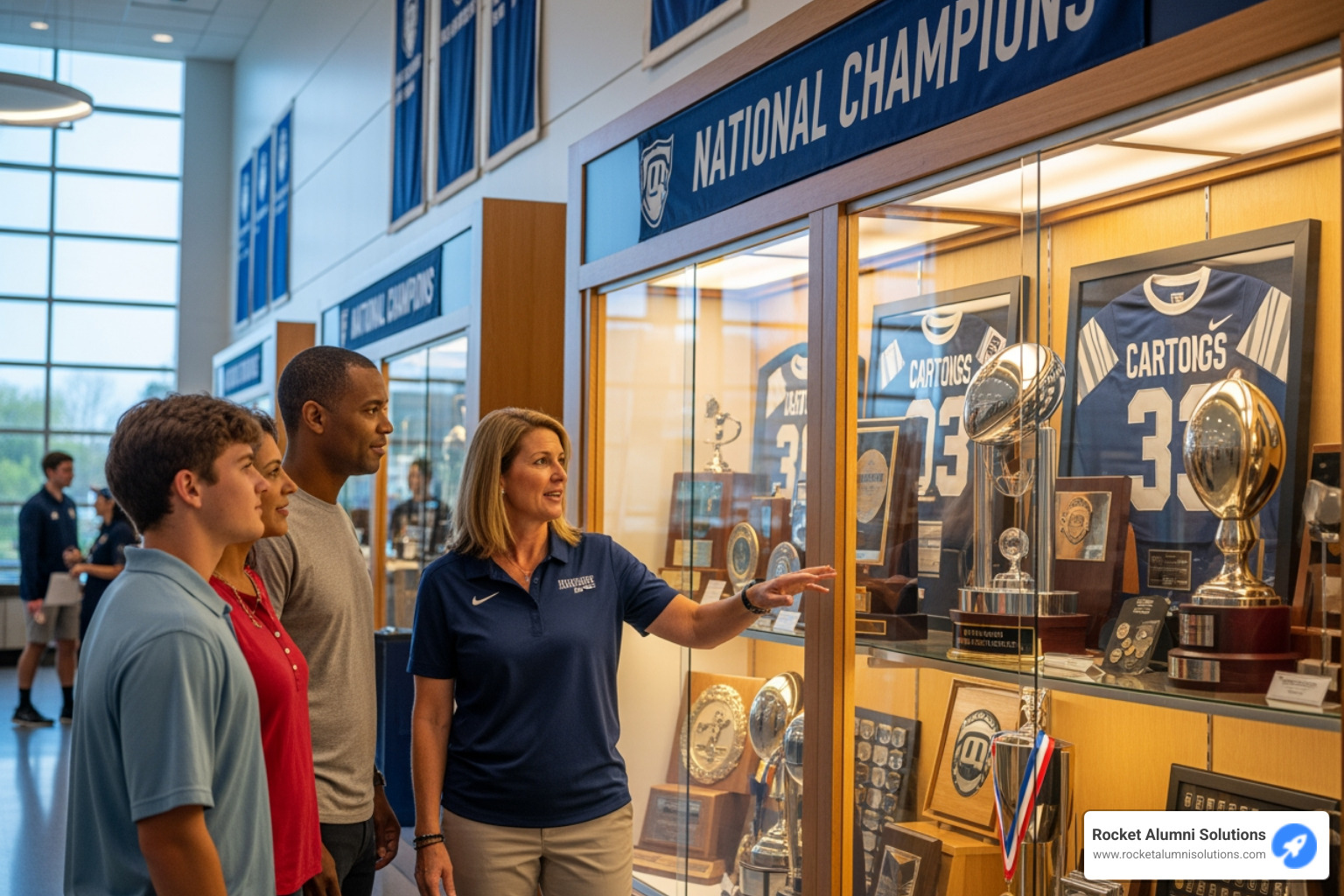
Budgeting for a State Championship Display Touchscreen
Understanding the true costs and potential returns helps you plan effectively and secure the funding your project needs. The initial investment might seem significant, but when you compare it against years of traditional recognition expenses, the math tells a compelling story.
A basic digital single-display system typically ranges from $8,000-$15,000, covering everything you need: hardware, software, professional installation, and staff training. For comprehensive multi-sport displays with multiple screens and extensive content development, you're looking at $15,000-$35,000. These figures reflect actual projects we've completed at schools across the country, including those in Delaware and Massachusetts.
Beyond the initial setup, you'll need to budget for annual software licensing, which generally costs $1,200-$6,000. This isn't just a fee—it covers cloud hosting, content delivery, ongoing feature updates, and technical support. Think of it as your maintenance plan that keeps everything running smoothly without requiring an IT department.
Here's where the investment really makes sense: traditional banners cost $200-$500 per championship, plus installation fees. For a school adding 8-10 banners annually, that's $2,400-$5,000 every single year, forever. Digital systems, with their unlimited capacity, typically reach break-even within 4-6 years and deliver positive returns within 5-7 years—all while providing vastly superior functionality. Our research on measuring ROI for digital hall of fame systems confirms these numbers across hundreds of installations.
| Cost Category | Traditional Method (10 years) | Digital System (10 years) |
|---|
| Initial Hardware | $0 (for banners/plaques) | $8,000 - $35,000 |
| Annual Additions | $24,000 - $50,000 (10 yrs @ $200-500/banner) | $0 (unlimited digital capacity) |
| Software/Support | $0 | $12,000 - $60,000 (10 yrs @ $1,200-6,000/yr) |
| Total 10-Year Cost | $24,000 - $50,000+ | $20,000 - $95,000 |
| Capacity | Limited (e.g., 80-100 banners) | Unlimited (hundreds of championships) |
| Updates | Manual, costly | Instant, cloud-based |
| Engagement | Passive (seconds) | Interactive (minutes) |
Schools have found creative ways to fund these projects beyond just athletic department budgets. Booster clubs and parent organizations often jump at the opportunity to support something this visible and lasting. Alumni donations through capital campaigns work particularly well—alumni love seeing their achievements honored in modern ways. Grants and educational technology funds can cover systems that recognize academic achievements alongside athletics. Some schools even secure corporate sponsorships, offering sponsors tasteful recognition within the display itself.
Your State Championship Display Touchscreen becomes a living testament to program excellence that works for you every single day, making it invaluable for both recruitment and alumni relations.
When prospective student-athletes and their families visit campus, that first impression matters tremendously. Athletic recruiting recognition displays create powerful moments during those critical campus tours. Coaches at schools like Virginia Tech and West Texas A&M University report that these displays demonstrate a clear tradition of success and a genuine commitment to honoring athletes. It shows recruits that joining your program offers realistic championship opportunities backed by decades of historical precedent, not just promises.
The impact goes beyond the immediate "wow factor." When recruits can interact with the display—searching for athletes from their hometown, watching championship game highlights, or exploring the program's evolution over time—they start imagining themselves as part of that legacy. It contributes to perceptions of program excellence that genuinely influence school choice decisions and athlete commitment.
For alumni engagement, the searchability of digital systems proves particularly valuable. Traditional banners force alumni to crane their necks scanning dozens of overhead displays, hoping to spot the years they competed. Digital search functionality enables instant findy of relevant content—just type in a name, year, or sport. This creates positive recognition experiences that foster genuine connections. Alumni engagement through interactive recognition displays shows how these touchpoints lead to increased participation in reunion programming and stronger fundraising initiatives.
The beauty of online halls of fame extends this engagement even further. Alumni living across the country or around the world can explore their championship seasons from anywhere, share their achievements on social media, and stay connected to the program year-round. It's not just about looking backward—it's about maintaining living relationships with people who care deeply about your school's success and are often in positions to support it financially and through mentorship.
Frequently Asked Questions about Championship Touchscreens
We hear a lot of thoughtful questions from schools considering a State Championship Display Touchscreen. These concerns are completely natural when you're making a significant investment in how your institution honors its history. Let me address the most common questions we encounter and share what we've learned from working with over 1,000 schools nationwide.
What happens to our physical trophies and banners?
This is probably the most frequent concern we hear, and I completely understand why. Those physical artifacts represent real victories, real athletes, and real moments in your school's history. The good news? Digital displays don't require eliminating physical artifacts—not even close.
Many schools adopt what we call a hybrid approach. They keep their most prestigious banners—state titles, national championships, conference dominance streaks—prominently displayed in the gymnasium where they belong. Those banners still hang from the rafters, creating that immediate visual impact when you walk into the gym. The touchscreen then serves as the comprehensive archive, telling the complete story behind each banner with photos, videos, player profiles, and season narratives.
For physical trophies, schools have found several smart solutions. Some create rotating displays where they showcase a select few trophies and change them periodically—maybe highlighting football trophies during fall, basketball during winter, and so on. Others choose to archive less prominent trophies in secure, climate-controlled storage, knowing their stories are fully preserved and accessible digitally. Some schools even return trophies to the teams or individual athletes who earned them, which creates wonderful personal connections while the digital display ensures the achievement remains part of the school's permanent record.
The digital system essentially becomes your institutional memory—the place where everything is preserved and accessible forever, regardless of physical space constraints.
How long does it take to digitize our school's championship history?
The timeline really depends on how deep your history goes and what resources you can dedicate to the project. We've seen schools take very different approaches, and both work well.
For a quick launch, many schools focus on the most recent 5-10 years of championships first. Information from recent years—digital photos, complete rosters, season statistics—is usually readily available. This approach can get your display up and running in just a few weeks, creating immediate excitement and momentum.
For schools wanting to go deeper, a comprehensive digitization project covering 50+ years of history typically takes 2-4 months of part-time effort from staff or student volunteers. Some schools make this a student project, involving history classes or yearbook staff in the research and digitization process. Others dedicate staff time during summer months when schedules are more flexible.
The beauty of a State Championship Display Touchscreen is that you don't have to digitize everything before launch. You can start with your priority content—maybe the last decade plus your most significant historical achievements—and gradually add more historical information over time. The cloud-based platform makes it easy to add content whenever you're ready.
Our production team, with over 10 years of content assistance experience, has helped schools like Pontiac High School and Heyworth High School through this process. We've developed efficient workflows for digitizing yearbooks and historical records that can significantly speed up the timeline.
Can the display be used for more than just athletics?
Absolutely—and honestly, we strongly encourage schools to think beyond just athletics. The most successful installations we've seen celebrate excellence across all domains of student achievement.
While a State Championship Display Touchscreen is fantastic for showcasing athletic championships, the same platform works beautifully for academic achievements. You can create dedicated sections recognizing National Merit Scholars, valedictorians, AP Scholars, academic decathlon winners, and science fair champions. Schools like Rockford University and Claremont McKenna University use comprehensive recognition systems that celebrate academic excellence alongside athletic success.
Fine arts achievements deserve recognition too—state band competitions, choir festivals, drama awards, debate championships, and visual arts honors. These students work just as hard and represent your school just as proudly as athletes do.
You can also highlight community service and leadership, honoring students who demonstrate exceptional character and make meaningful contributions to their communities. This creates a more complete picture of what your school values and celebrates.
Integrating diverse achievements maximizes your investment's value while sending a powerful message: your institution values student success across all domains, not just on the athletic field. It builds a culture that celebrates every form of excellence, which resonates deeply with students, families, and the broader community.
The platform is flexible enough to handle all of this within a single system, with intuitive navigation that lets users explore the specific areas most meaningful to them. This comprehensive approach is what truly transforms a championship display into a complete institutional recognition system.
Conclusion: Build a Lasting Legacy of Excellence
The journey from traditional banners and overflowing trophy cases to a dynamic State Championship Display Touchscreen represents more than just a technology upgrade—it's a fundamental shift in how your school honors its past and inspires its future. When you make this move, you're not just solving the problem of limited space or faded banners. You're changing static facts into engaging stories that truly resonate with students, alumni, and visitors.
Think about what this means for your school community. Every championship, every hard-fought victory, every moment of athletic excellence—all preserved permanently and accessible to anyone who wants to explore your program's history. Current students can search for their parents' or grandparents' achievements from decades earlier. Alumni visiting for homecoming can relive their championship seasons with photos and videos. Prospective athletes and their families can dive deep into your tradition of excellence, seeing concrete proof that your program develops champions.
Through our work with over 1,000 installations across the country—from small rural schools to major institutions like Amherst College and the University of North Texas—we've witnessed the transformative power of comprehensive digital recognition. Championship accomplishments deserve recognition that honors their significance while inspiring current and future athletes. A State Championship Display Touchscreen becomes more than just a display; it's an investment in your school's narrative, a powerful tool for engagement, and a lasting testament to the enduring power of hard work and dedication.
The benefits extend far beyond the physical display itself. You'll build a stronger culture of pride that celebrates excellence across all programs. You'll create powerful connections with alumni who can finally find their own achievements easily. You'll motivate the next generation of champions by showing them the incredible legacy they're joining. And perhaps most importantly, you'll ensure that no achievement is ever forgotten, hidden away in storage, or lost to time.
For schools ready to celebrate every achievement and preserve their championship legacy for generations to come, Rocket Alumni Solutions provides a purpose-built platform designed specifically for athletic and academic recognition. Our cloud-based system makes content management simple, our hardware is built for decades of reliable use, and our team brings over 10 years of experience helping schools tell their stories effectively. Explore interactive touchscreen software to see how you can bring your school's championship history to life and create a recognition experience worthy of your athletes' achievements.



















































































































